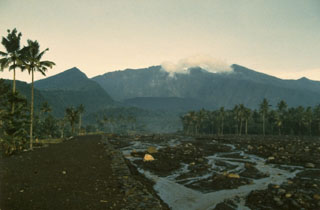Report on Galunggung (Indonesia) — 16 July-22 July 2008
Smithsonian Institution / US Geological Survey
Weekly Volcanic Activity Report, 16 July-22 July 2008
Managing Editor: Sally Sennert.
Please cite this report as:
Global Volcanism Program, 2008. Report on Galunggung (Indonesia) (Sennert, S, ed.). Weekly Volcanic Activity Report, 16 July-22 July 2008. Smithsonian Institution and US Geological Survey.
Galunggung
Indonesia
7.25°S, 108.058°E; summit elev. 2168 m
All times are local (unless otherwise noted)
Based on a pilot report and inconclusive observations of satellite imagery, the Darwin VAAC reported that on 17 July a possible ash plume from Galunggung rose to an altitude of 5.5 km (18,000 ft) a.s.l. and drifted SW. CVGHM did not report eruptive activity and advised that the activity status was "normal."
Geological Summary. The forested slopes of Galunggung in western Java SE of Bandung are cut by a 2-km-wide collapse scarp open towards the ESE. The "Ten Thousand Hills of Tasikmalaya" dotting the plain below the volcano are debris-avalanche hummocks from the collapse about 4,200 years ago. An eruption in 1822 produced pyroclastic flows and lahars that killed over 4,000 people. A series of major explosive eruptions starting in April 1982 destroyed a number of villages, killed as many as 30 people, and forced over 60,000 to evacuate. Pyroclastic flows and heavy widespread ash caused significant damage. A large passenger jet that encountered the ash plume on 24 June lost power to all four engines but managed to land safely in Jakarta. The 1982 activity destroyed a 1918 dome and formed the Warirang crater, almost as wide as the valley, about 2 km down from the summit.

